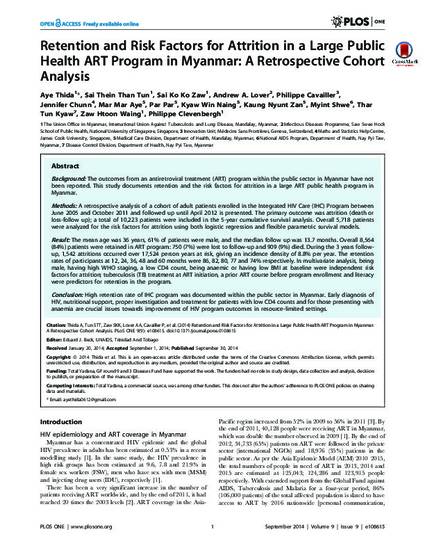
Article
Retention and Risk Factors for Attrition in a Large Public Health ART Program in Myanmar: A Retrospective Cohort Analysis
PLOS One
(2014)
Abstract
Background
The outcomes from an antiretroviral treatment (ART) program within the public sector in Myanmar have not been reported. This study documents retention and the risk factors for attrition in a large ART public health program in Myanmar.
Methods
A retrospective analysis of a cohort of adult patients enrolled in the Integrated HIV Care (IHC) Program between June 2005 and October 2011 and followed up until April 2012 is presented. The primary outcome was attrition (death or loss-follow up); a total of 10,223 patients were included in the 5-year cumulative survival analysis. Overall 5,718 patients were analyzed for the risk factors for attrition using both logistic regression and flexible parametric survival models.
Result
The mean age was 36 years, 61% of patients were male, and the median follow up was 13.7 months. Overall 8,564 (84%) patients were retained in ART program: 750 (7%) were lost to follow-up and 909 (9%) died. During the 3 years follow-up, 1,542 attritions occurred over 17,524 person years at risk, giving an incidence density of 8.8% per year. The retention rates of participants at 12, 24, 36, 48 and 60 months were 86, 82, 80, 77 and 74% respectively. In multivariate analysis, being male, having high WHO staging, a low CD4 count, being anaemic or having low BMI at baseline were independent risk factors for attrition; tuberculosis (TB) treatment at ART initiation, a prior ART course before program enrollment and literacy were predictors for retention in the program.
Conclusion
High retention rate of IHC program was documented within the public sector in Myanmar. Early diagnosis of HIV, nutritional support, proper investigation and treatment for patients with low CD4 counts and for those presenting with anaemia are crucial issues towards improvement of HIV program outcomes in resource-limited settings.
Disciplines
Publication Date
2014
DOI
https://doi.org/10.1371/journal.pone.0108615
Citation Information
Aye Thida, Sai Thein Than Tun, Sai Ko Ko Zaw, Andrew A. Lover, et al.. "Retention and Risk Factors for Attrition in a Large Public Health ART Program in Myanmar: A Retrospective Cohort Analysis" PLOS One (2014) Available at: http://works.bepress.com/andrew-lover/5/
Creative Commons license

This work is licensed under a Creative Commons CC_BY International License.
